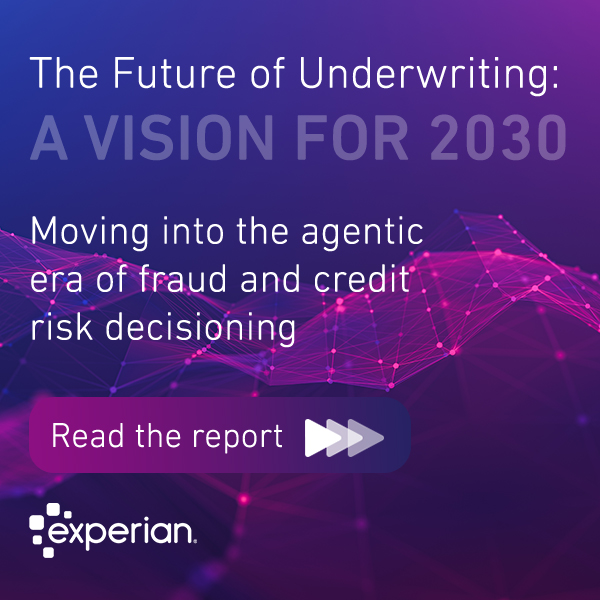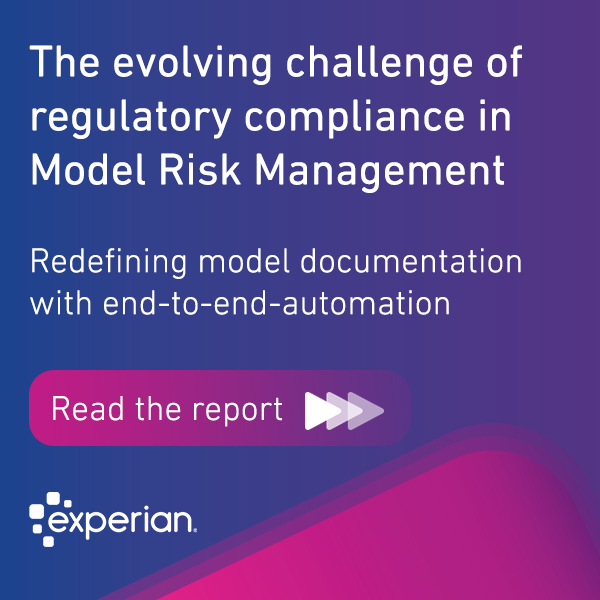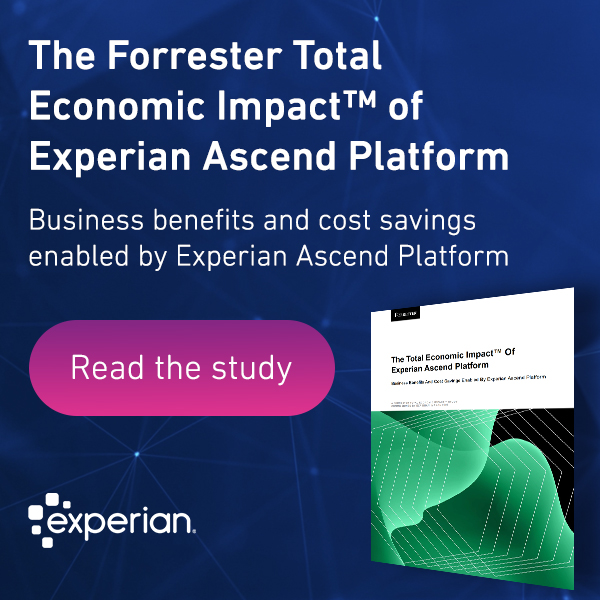Search Results for: ai

Whether you work for a small or big company, chances are you’ve seen budgets contract in the wake of Covid-19. There are a lot of factors contributing to it: fluctuating economic outlooks, building up loan loss reserves, and re-directing expenditures to keep employees and customers safe and secure. A recent global study of banks and retailers found that the top area of short-term investment was securing the mobile and digital channels. In fact, it also showed that 80% of businesses put a digital identity strategy in place, a 30-point increase since Covid-19 began and 60% of businesses are planning to increase their budgets for credit risk analytics and fraud prevention, respectively. So why is it that only 32% of banks and retailers feel operationally ready for their customer’s continued demand for digital engagement? The Capex required to invest in new technology these days requires a fiercely competitive business case. Not forgetting to mention, if approved, it could be a while before you see a return on your investment. But it doesn’t mean the latest advancements and innovation available for managing credit risk or fraud risk is out of reach. Getting more out of your existing tools and technologies is easier to implement and quick to deliver results. In fact, since Covid-19 began, hundreds of clients have optimized their use of credit and fraud risk software and analytics, helping them focus on creating more meaningful customer relationships and saving them millions in potential losses. Here are two examples of how you can get the most out of your existing technologies today and a checklist for evaluating your current tools. Device recognition Beyond securing systems against Cybersecurity threats, businesses need to think like the criminals they’re trying to deflect. If it seems like the world all went digital overnight because of Covid-19, then you can bet fraudsters were one step ahead exploiting the blind spots in the customer relationships you quickly moved online. But how do you recognize your customer behind their mobile device or computer screen? One way is to discern a fraudulent (or “mimic”) device from a genuine one. Having access to this information allows you to swiftly see the same device repeating both good and bad behavior and thus have a better chance of isolating the mimic device and mitigating fraud attacks. This is done by creating a strong probabilistic measure to determine whether two events are from the same device or not. How does this help? It helps to reduce over-firing fraud velocity rules and more precisely out-sort fraud events for manual review. It’s not as complicated as it sounds, and many businesses already have access to this device intelligence data which simply requires them to either turn it on or upgrade their fraud management systems to its latest version. In fact, additional device data points are always being added, and upgrading this layer is often recommended as it can provide up to 85% improvement in performance. Bottom-line: Device data bolster the effectiveness of your customer identity and fraud defenses with little impact on operational resources and reduces friction on your customer’s digital experience. Machine learning Innovations in decision management are having an impact on areas traditionally associated with predicting consumer behavior, such as credit risk, collections, and fraud detection. The ubiquity of data nowadays requires the methods used to derive actionable insights to evolve and most lenders globally have started to adopt advanced analytics. Nearly 70% of businesses increasing their use of machine learning for determining creditworthiness since Covid-19 began. For the collections process, it has helped to determine the best way to contact a delinquent customer or the best treatment to use as a customer exits Covid-induced forbearance? For card, mortgage, and automotive portfolios, machine learning has played a strategic role in creating and implementing pricing strategies to determine the most accurate decisions for financing terms. Perhaps it’s in fraud detection where machine learning is having the biggest impact. Unlike how it’s applied in credit risk decision strategies, machine learning used for fraud detection can be trained to learn and improve with experience without explicitly being told to do so. It excels at solving problems where the “problem space” cannot be defined easily by rules, which makes it a great complement to mature rules-based fraud management systems. Furthermore, machine learning models can take advantage of the different data points from all backing applications at the time of any single transaction, login, or submission. This produces a final decision that’s more accurate than that produced by a simple rules-based approach or manual decision matrix. Attributes that once provided minimal lift when analyzed in a silo may now provide a substantial lift to predict credit risk or prevent a fraud attack when combined with multiple data elements. Conversely, legitimate events that were inadvertently triggered by traditional fraud detection methods can be identified as authentic before having a negative impact on the customer’s experience. Bottom-line: A layered approach continues to be a key component in any credit decision or fraud detection solution and machine-learning models are the final call in your decision workflow strategy so they can leverage all the previous decision data. Checklist: Evaluate whether you’re getting the most from your decision technology Is your current solution providing the results you need? Avoid comfort in patterns and request a business review of your current solution to analyze performance. It may reveal unknown gaps and opportunities to improve your business results. How do your results compare to your peers? Some peer benchmarking is publicly available, but most vendors offer peer (blind) benchmarking using your specific performance data. It’s worth the ask! Are you using all the functionality your tool has to offer? Sometimes decision technology is implemented with a myopic focus on solving a specific problem or used in a specific area despite a broad range of functionality available that covers more use cases. Are you using the most up-to-date version of your tools? Check with your vendor right away and stay informed regarding newer versions. Upgrades generally require less effort and cost than a new solution and by continuously monitoring for the latest version, you’re able to meet current regulatory and policy standards. Are there any ‘add-ons’ available? Your existing decision technology may offer add-ons to enhance your current solution. Add-ons such as new or enriched data sets, updated scores or models or new software features may extend the business usage of a solution to different processes and within additional departments. Are your technologies integrated to enhance your credit risk and fraud risk decision workflow? Integrating your technologies can help you to execute credit and fraud strategies seamlessly with less chance for error, manual intervention, or duplicating actions across disparate systems. Technology is critical in meeting customer demand and staying competitive in any market. It can help balance the demand for internal resources while providing the service your customers deserve. But as organizations look to stay competitive, and agile through a volatile economic time, remember the importance and tangible benefits of optimizing what you already have in place. Related articles: Global research study: The impact of Covid-19 on consumer behaviors and business strategies Podcast: Banking trends and opportunities in the post-Covid-19 era Are traditional online identification methods becoming obsolete? Case study: Layered behavioral biometrics, device intelligence and machine learning

To keep you informed, we’ve gathered the top global, August headlines covering the latest insights from our experts and recent hot topics. Email attack type: Account takeoverZDNet Japan covers ATO (account takeover) fraud and the variety of techniques used in this attack type to access user accounts and ultimately steal money or sensitive information. In today’s rapidly changing economy, businesses need to get consumer recognition rightDavid Britton, VP of Global Identity & Fraud, shares insights on the disparity between businesses' confidence in recognizing consumers and consumers' lower confidence in this capability by these businesses. EDBI invests in fraud protection fintech VestaThe Straits Times, Singapore, provides an overview of this investment, including details around the increase in online fraud losses recognized across the Asia Pacific (APAC). How banks can balance UX and security amid a pandemicThis Forbes article explores the impact of Covid-19 on consumers, including the critical need for banks to balance consumer protection and good user experience. Stay in the know with our latest insights:

It was Dr. Simon Ramo’s vision of a ‘cashless society’, made possible by information and technology, that led to the creation of Experian’s business in the U.S. in the 1960s. He could see how information was going to change the way people lived and envisioned a future where systems would enable the rapid transfer of information to establish patterns of payment and individual creditworthiness. The democratization of digital financial tools and initiatives to improve financial literacy can create promising beginnings for countless disadvantaged individuals. Fast-forward to the present, and the global Covid-19 (Coronavirus) pandemic has taken the world by storm, proving a catalyst for an accelerated path towards a cashless society. Our recent proprietary research indicates that: Since Covid-19, we’ve seen growth in the use of mobile wallets (+8%), such as Apple Pay, and retail apps (+6%), such as Starbucks. The largest areas of growth for using digital payment methods are online grocery shopping (+7% increase) and ordering food (+6%). 50% of consumers globally intend to increase their online activities (banking, payments and shopping) in the next 12-months. Over the past decades, many developing countries such as India and China have recognized the value digital payments deliver to communities. Those governments are fully invested in their cashless society initiatives with a view to increase financial inclusion, improve security, boost trust online, and leverage their high mobile penetration rates to expand the adoption of mobile payments and services. A cashless society brings greater visibility into a larger number of transactions, reducing the potential risk of money laundering, bribery and corruption. It also allows central banks to have a more accurate view into how much money is in circulation, helping them prevent cash hoarding. On the other hand, businesses don’t need to maintain cash reserves, bank their cash payments or pay bank charges for withdrawing physical currency, which means that less ATMs to service and less cash to process leads to more resources to put at the service of their customers. More about our research From June 30 – July 7, 2020, we commissioned an independent research firm to survey consumers and businesses in 10 countries worldwide to understand the impact of Covid-19 on changing consumer trends and behaviors and business strategies and operations. >> See New global research insights: The impact of Covid-19 on consumer behaviors and business strategies for more insights from this study

As businesses continue to figure out the best way to operate through the global pandemic, I’ve been asked by leaders across industries to provide my thoughts and insights around the path forward for businesses, specifically around where to invest and how to manage distributed teams. While my experience drives how I answer these common questions, Experian recently released the results of a global study which helps to demonstrate where businesses are focusing their resources. In a recent global survey among financial services and eCommerce businesses, we found that most companies are focusing on the health and safety of employees and customers, with 42% of those surveyed saying this was their primary focus. Following closely was 32% of businesses who said making operational changes and managing increases in demand across channels and functions is their greatest challenge. That’s a shift from pre-pandemic times when firms were spending more on mobile and digital advancements with intent to strengthen the security of mobile/digital channels, invest advanced analytics (e.g. creation of artificial intelligence models), and improving customer digital account opening and engagement. Top questions I’ve received in the past few months: Q: As someone with extensive experience managing technology for a distributed team, what advice would you impart to other leaders addressing this for the first time? A: I don't think there is a single answer, but there are a few things that are mostly common sense. For example, there is a lot of ad-hoc interaction happening in an office. Therefore, consider increasing frequency of any common team and wider meetings, remotely(all-hands, daily stand-ups, staff meetings, or ask-me-anything type of meetings). To compensate for the increase in frequency, consider making these meetings shorter. Another thing is to encourage people to be on video - it adds presence and makes it much easier to collaborate. Also, make sure you have efficient comms-channels (Slack, Teams, Skype, or whatever tool your company uses) which helps with the asynchronous flow and lets everyone jump in. And put the effort in to get good tools. Poor quality connections and audio saps energy and makes it frustrating instead of being useful. It also helps during larger meetings: That way everyone can comment and jump in through a different means, without interrupting. It is also useful to be a bit more disciplined when running meetings. There are many non-verbal cues when we communicate, so to compensate for this a bit more structure (somebody moderating the discussion) may help. Conducting surveys afterward to find out what people find interesting is useful and I also think it is important to talk about the situation, making sure that people can be transparent and recognizing challenges. Finally, in the current situation, where many people have had to adjust their daily lives, we’ve seen a lot of innovation amongst the teams. Anything from virtual coffee breaks outside of regular meetings to virtual curry nights and meet-ups. I think it depends on your team's circumstances but what matters is to stay in close contact. Q: What areas do you believe are most in need of advancement in light of the ongoing global crisis and why? It is hard to predict all of the lasting changes, but I think we will see a continuing acceleration to digital, and some industries that have not had to may now be forced to shift faster — and leaders will need to balance such focus with their priority to best assist employees in a remote environment. According to a recent survey, we know that 50% of consumers anticipate increased spending on items purchased online versus in-person – both in the short-term and within the next 12 months. So, we’ll continue to see people using both remote and digital ways of working, shopping and entertainment, and that will of course continue to drive the need for companies to think about their digital offerings. And, by extension how to appropriately secure those transactions for the associated risk and how to make a smooth customer onboarding journey that can be fully digital. I also believe we will see a lot of new and creative use cases from software and analytics, specifically the role of AI. Specifically, we’re seeing rapid changes in behaviors and volumes, and this again emphasizes how important it is to have resilient and scalable systems that can turn around quickly. The current circumstances also highlight the importance and opportunity to take the data we have and apply analytics to drive insight into what impacts we may see and adjust our plans accordingly. This is also an area where businesses are investing. 60% of businesses we surveyed plan to increase their budget for analytics and credit risk management and businesses in the U.K., U.S., Australia, and Spain have already increased adoption of AI and advanced analytics, since Covid-19 began. I’ll continue to monitor these key areas and share significant findings, especially as the pandemic plays out longer than any of us hoped and as businesses start re-opening offices while disparate employees make the best use of resources to support customers. For more about our recent study, check out some highlights here. If you'd like to submit a question to Birger, please email GlobalInsights@experian.com

In this episode of Insights in Action, we talk with Derek Garriock, Design & Innovation Director at Experian and David Bernard, SVP of Global Marketing & Strategy at Experian Decision Analytics, about the future of banking and trends and opportunities arising in the post-Covid-19 crisis era. The future of banking is being shaped, in part, by people's response to Covid-19 There is adaptation to the current crisis, but even as we start to progressively get out of lockdown in a number of countries, banks have realized there are a number of deeper things around their use of analytics, the fine-tuning of their scorecards, lending strategies and risk strategies that have to be redone. Also, there’s the general, longer-term trend towards moving some of their banking structure to the cloud, making sure that their decision strategies are fit for purpose, that they are flexible enough, building attributes into the system. So, there are a number of programs that are continuing and sometimes accelerating. David Bernard, SVP, Global Strategy & Marketing, Experian Decision Analytics Questions answered include: Are we already on the path to a different way of banking? Speed, convenience, and choice have gained a different meaning, accelerating digitalization efforts and demands virtually overnight. What are the current areas of focus for the industry based on experiences with financial institutions globally? Has this Covid-19 crisis further challenged the status quo in the industry and what is the anticipated impact between traditional financial services and fintech challengers? What are the pillars of a successful modern banking infrastructure, and what promising technologies can help meet new market dynamics? Related content: The role of the virtual assistant: What businesses can do to ensure consumer demand is met while taking care of customer experience Maximizing impact from AI investment: 4 pillars of holistic AI Be mindful of these 3 Strategies when engaging customers digitally

As consumer organizations settle into the so-called new normal, behaviors have dramatically changed and expectations have been redefined. Speed, convenience, and choice have gained a different meaning, accelerating digitalization efforts and demands virtually overnight. Recently, we spoke with our internal experts – Derek Garriock, Design & Innovation Director at Experian and David Bernard, SVP of Global Marketing & Strategy at Experian Decision Analytics – about the future of banking and trends and opportunities arising in the post-crisis era. Here’s highlights of that discussion: A different way of understanding and doing banking – a viewpoint by Derek Garriock Industries are redefined by changes in consumer behavior, and certainly, the crisis that’s been unfolding across the globe has had a big impact in terms of how we live our day-to-day lives. These changes are reflected in the demands made of banks, as we try to manage our money in a different way. The challenge that the banks and lenders have seen across the globe is obviously different levels of reaction from consumers and businesses — depending on the jurisdiction that they’re in and the immediate need that’s created. This challenge is more about how you are able to adapt given that going forward this behavioral change will be no doubt be one of the lasting impacts of the crisis. At a very basic level for banks, we still have some of the pre-existing challenges around how they deliver change in a digital world to really serve customers and give them the best possible experience and journeys to serve their needs. Obviously, there’s a lot of regulation banks are required to observe and follow as an organization doing the type of business that they do — but the current needs shine a light on big areas of focus that probably haven’t changed in the last decade — around how do you digitize your business to reduce cost, to better serve your customers, and to be in a place where you drive deeper share of wallet with customers to grow your business. What we’ve seen through the crisis is really a spotlight shone on this area and in the context of how to move quicker, faster, better, and to deliver against some of those core objectives. Current areas of focus for the global banking industry – a viewpoint by David Bernard Thinking about the immediate reaction to the crisis, we have a number of banks that are still focused on coping with lockdowns and business continuity across the globe — managing going into lockdown and out of lockdown across different countries. For example, we had banks in the UK that have call centers in India. When the India lockdown happened, very suddenly they lost their ability to respond to clients over the phone — so we see some immediate impacts of the crisis with banks coping with a situation where different parts of the globe are challenged from a business continuity perspective. Banks also had to adapt to a number of government programs such as government-sponsored loans for small businesses and individuals. They had to adapt details like their scorecards for lending, or their scorecards for debt collections — evaluating their approach to debt collections since suddenly you have a lot of people that lost their jobs. Asking for last month’s bank statements doesn’t quite give you the right view of their personal situation. There is adaptation to the current crisis, but even as we start to progressively get out of lockdown in a number of countries, banks have realized there are a number of deeper things around their use of analytics, the fine-tuning of their scorecards, lending strategies and risk strategies that have to be redone. Also, there’s the general, longer-term trend towards moving some of their banking structure to the cloud, making sure that their decision strategies are fit for purpose, that they are flexible enough, building attributes into the system. So, there are a number of programs that are continuing and sometimes accelerating. There is also the example of digital interfaces where it looks like you can do something in an app on the website, but behind the scenes, a number of banks have analog processors — non-digital processors — where there are people reading data internal in the system or doing some manual task behind the scenes and the whole crisis is shedding light on those examples and forcing more complete digitization across the board. Listen to the full podcast: https://bit.ly/IIA_FutureFS Related articles: Digital transformation through cloud-first decisioning by Chris Fletcher, SVP Decision Management & Cloud Services & David Britton, VP Of Industry Solutions Maximizing impact from AI investment: 4 pillars of holistic AI by Shri Santhanam, Global Head Of Advanced Analytics & AI & Birger Thorburn, Chief Technology Officer, Global Decision Analytics How rapidly changing environments are accelerating the need for AI and Machine Learning in business by Birger Thorburn, Chief Technology Officer, Global Decision Analytics

The global pandemic led to swift and unexpected shifts in consumer behavior, from the significant increase in the use of digital channels, to the decrease in ability to pay for many. Based on this environment, we’ll highlight where senior financial services executives should focus their analytics and decisioning teams’ efforts to provide a bit of certainty in an uncertain time: Confidence and demand for credit First off, it’s important that lenders consider current dynamics when monitoring and measuring the effect of fluctuating market conditions on their portfolio. Overall lower consumer confidence in the ability to access credit is not surprising, but the true impact on demand for credit is yet to be concluded. “As a result of both the pandemic itself and the changed economic conditions it caused, consumers’ appetite for new credit and the ways in which they are using existing credit are in flux.” – Leslie Parrish, “Uncertainty Is Certain: Consumers’ Financial Outlook at Mid-Year 2020,” Aite Group, July 2020 From late June to early July 2020, we surveyed 3,000 consumers and 900 businesses in 10 countries. This research indicates some consumers are responding to economic uncertainty by reducing spend and tapping into financial reserves, while other consumers are using credit to make strategic decisions such as refinancing, buying a new house, or opening new lines of credit for access to money. Regardless of customer sentiment, it's important for businesses to understand these realities: Consumer demand for digital is increasing — our research shows it's gone up 20% since Covid-19 Digital channels will help fuel new business — with a marked 40% increase in consumers opening new loans digitally based on our research These indicators should drive investment in solutions to secure the digital channel and improve digital onboarding, including data, analytics, and technology. Such investments help meet consumers’ digital demands, safeguarding your ability to retain existing customers and win new business. >> Download the Global Insights Report Ability to pay Lenders should also be mindful of the volatility of the current environment and ensure their teams rely on data and analytics that enable accurate decisions based on a consumer’s current financial situation. Given active programs established to supplement a decline in consumer income, we are still enjoying a nourished economic environment. However, our research shows that globally, since Covid-19 began, the number of consumers having difficulty paying their bills has doubled, and according to Aite Group, half of consumers in the U.S. reported their household has suffered a loss of employment income since mid-March.1 These conditions enforce the need to have the right tools in place to best assess consumer creditworthiness. Decisioning in the new norm As lenders continue to focus on business health, it’s key to consider operational efficiency and ongoing optimization. Given there is no precedent to the current global pandemic, lenders will need to rely on innovative solutions to learn and adapt in real-time. Our research shows that many businesses know change is needed and are seeking solutions to tackling this challenge. One in five businesses globally lack confidence in the effectiveness of their credit risk and collection decisions since Covid-19 began. Sixty percent plan to increase budget for analytics and credit risk management. Meanwhile, the top three solutions businesses believe will improve operational efficiency when supporting customers’ financial needs are: automated decision management, cloud-based applications, and artificial intelligence. To keep pace and be successful through this unchartered territory, lenders must leverage innovative technologies such as cloud-enabled solutions, artificial intelligence, and machine learning. Though today’s lending environment is likely to include levels of volatility for some time, making the right adjustments now can help lenders support consumers and business performance in the long term. >> Get more insights on the impact of Covid-19 on consumer behaviors and business strategies _____ 1 “Uncertainty Is Certain: Consumers’ Financial Outlook at Mid-Year 2020,” Aite Group, July 2020

Download the report People’s changing behaviors to safeguard their health during the ongoing global Coronavirus pandemic has fueled a massive shift to digital channels. As people’s day-to-day routines and behaviors shift, so too is the attention on businesses to find new ways of staying relevant to their customers. Two-thirds of consumers are staying loyal to the businesses they preferred prior to Covid-19. 20% increase in overall online transactions – a 41% increase in online grocery shopping, 40% increase in applying for loans online, and a 22% increase in food delivery or takeout. 50% of consumers surveyed expect to increase their online transactions even more in the next 12-months. Uncertainty for what the next 6-12 months will hold has people and businesses vacillating between optimism and pessimism. Some likely contributing factors could be public health gains and setbacks for containing the virus, some businesses opening only to close again, and the prospect of some students returning to school in-person and while others go remote – and what all of that means for economic recovery. At the time of our study (June 30 -July 7, 2020), some lenders and retailers are demonstrating more confidence than others, while consumers - many already feeling depleted - are expecting and bracing for an expected second wave of Covid-19. Consumer financial hardship 65% of people believe their country has not yet recovered from the economic impact of the pandemic. 30% of consumers reported a decline in household income; India saw the largest household decline at 43%. The number of people having difficulty paying their bills has doubled since Covid-19 began. Businesses operational challenges 53% of businesses believe their operational processes have mostly or completely recovered since Covid-19 began. The U.S. (80%) is the most confident and Germany (27%) is the least. Top challenges faced by most businesses globally are the health and safety of their employees and customers, adjusting operations to support customers, and managing increased demand across channels and functions. 1 in 5 businesses surveyed lacks confidence in the effectiveness of their credit risk and collection decisions since Covid-19 began. Beyond their intense focus on the safety and security of their employees and customers, our research shows that businesses are making strategic investments – to give consumers greater access to goods and services, and to better manage their customer relationships. They’re also exploring automation and cloud technology to relieve operational constraints. Whether it’s a lender providing financial assistance to small businesses and loan re-payment options to customers or it’s a retailer providing essential supplies and services to people who need it most, helping people and delivering on expectations for secure, relevant customer experience is top of mind. Top areas of investment: strengthening the security of mobile and digital channels, new credit risk analytics, and the creation of artificial intelligence (AI) models and increasing digital customer acquisition and engagement. Top 3 solutions businesses believe will improve operational efficiency when supporting customers’ financial needs are automated decision management, cloud-based applications, and artificial intelligence. 60% of businesses plan to increase the budget for analytics and credit risk management. Businesses in the UK, U.S., Australia, and Spain have already increased the adoption of AI and advanced analytics. To solve for the lack of economic precedent, 51% of businesses say they’re asking customers to contribute more information/data and 49% say they’re exploring new or alternative data sources. Download Experian's Decision Analytics Global Insights Report July/August 2020 and learn more about the impact of Covid-19 on consumer behaviors and business strategies

ITProPortal: Accelerating forward: how Covid-19 has changed banking forever Digital Journal: Q&A: Importance of fraud trends as businesses open up Forbes: Businesses Need To Modernize Their Approach For Delivering Digital Experiences Auto Fin Journal: Experian's 2 latest moves to combat fraud Artificially Intelligent: AI at Experian with Shri Santhanam (podcast) How banks can balance UX and security amid a pandemic EDBI invests in fraud protection fintech Vesta In today's rapidly changing economy, businesses need to get consumer recognition right Email attack type: Account takeover Transforming analytics into business impact Global shudder: How businesses and customers are reacting to Covid-19 Experian touts BioCatch behavioral biometrics, adds Onfido face authentication for onboarding Experian's cloud-based solutions adapt to today's evolving customer needs Why businesses need to meet the challenge of digital acceleration Q&A: Consumer and business outlooks since Covid-19 #TradeTalks: The Shift in Online Trends as a result of #COVID19 43% of Indian consumers record decline in household income: Experian Global Qual será a velocidade da retomada da economia brasileira em 2021? (What will be the speed of the return of the Brazilian economy in 2021?)

Chris Ryan, Senior Fraud Business Consultant, talks to Nick Zulovich at the Auto Remarketing podcast about the new ways we are seeing fraud surface as the global pandemic evolves. "The pattern of activity that we're seeing that has really attracted my interest is this notion of human farming. A human farm is a pool of paid labor who research information on potential fraud victims using data that's been stolen through data breaches and using information that people publish through social media and other outlets. The objective of a human farmer is to be able to assemble a detailed profile of a potential fraud victim so that the perpetrator can better impersonate them and navigate around potential security measures and other obstacles that would normally be in the way." Chris Ryan, Senior Fraud Business Consultant Why the opportunity for human farming? People are out of work so there's a recruitment opportunity for those in need of an income. There is a flood of people into the online space who might not ordinarily engage digitally. This demographic may not be tech-savvy and maybe more susceptible to fraud methods such as phishing. Resources that typically screen for fraud are suffering due to office closures. The combination of high tech fraud to find potential victims plus skilled human intelligence makes these methods highly effective. New trend amidst new circumstances - the rise of synthetic ID Remote transactions combined with the high-value nature of the auto industry makes it a very attractive prospect to fraudsters. Even though purchases are down, the fraudsters are still active. Synthetic identity fraud, in particular, continues to be attractive because the identities are not real and therefore not suffering from the same downturn as genuine profiles. Listen to the full podcast here. Related articles: Getting to grips with the shifting fraud landscape Infographic: Top Global Fraud Trends 2020 Covid-19 as a Gateway to Fraud: Top 5 Global Fraud Trends to Watch Out for in 2020

Insights from Harry Singh, SVP, Global Decisioning, and Hristo Zahariev, Global Product Manager. Due to the global pandemic, one of the key challenges facing many consumers today is the ability to obtain support either from their credit provider or from government. This is manifesting itself in two ways – consumers facing very short-term financial difficulty, which might mean a payment holiday for a few months, or longer-term structural issues such as unemployment, which requires a very different set of treatments and outcomes. But what can businesses do to ensure consumer demand is met while taking care of customer experience? We look at the importance of digital channels within the decisioning environment, and how investment using AI can not only lead to consumer satisfaction now but also a sound business strategy for the future, regardless of how unpredictable that future may be. How the industry can respond to consumers during this time of need A recent study from March this year looked at businesses that are not yet fully digital in terms of how they handle their consumer interactions, and how they can reach out to consumers to help them during the Covid-19 crisis. With call centers and operational centers closed, and anything between five and 50,000 applications a week coming into banks across the world since the pandemic began, businesses have inevitably been struggling with demand. Based on existing operational models examined within the study, if businesses were to manually manage these applications, they would need to double in size in terms of full-time employees, and follow-up interactions post approval may still not be met. Managing demand and staying compliant, while enabling consumers to successfully interreact without waiting hours to get through is the challenge faced by many businesses. It’s a balancing act that is both an opportunity and a risk and should be treated as such. Helping consumers in a way that is digital, while allowing for self-serve, is fundamental in meeting these new levels of demand - and doing so in a way that doesn’t feel demeaning to the consumer is where true differentiation begins. During a stressful time for consumers, it’s important that businesses step up to the challenge of demystifying their interactions, removing embarrassment around finances while also retaining an element of human engagement. Thanks to AI and a layered, cloud-first approach to decisioning, contacting pre-qualified consumers for both forbearance and hardship can now be done through a business’s banking application or their website, using artificially intelligent virtual assistants that can be deployed in a multitude of different digital channels. The consumer perspective: we need more than a chatbot Chatbots are very effective and useful in many ways, but when an interaction gets complex or there's something of a regulated or more subjective nature, it becomes difficult for that chatbot to provide the kind of service consumers are looking for. The answer lies in continuous learning, which moves away from the decision tree structure of a traditional chatbot and into the realms of natural language processing. The new age of virtual assistant remembers interactions and then learns from them, has short-term and long-term conversation goals, and recognizes small talk. The result feels a lot more empathetic and allows for always-on and real-time consumer interaction. How businesses can develop their strategies not only for today, but going forward Bringing together digital capabilities, analytical insights, and data to understand the affordability of a consumer is critical. Using demographic and geographic data, businesses need those insights, regardless of whether we are in a growth environment, a benign environment, or as we're seeing right now, a recession of macro-economic downturn. Businesses choosing to invest now to address their operational and strategic challenges are not just responding to Covid-19, they are looking beyond and into strategic requirements of the future. Financial difficulty may be more acute right now, but it has always existed and always will, for various reasons.

In this episode of the Insights in Action podcast we talk to Neil Stephenson, Vice President of Strategic Client Development, about how businesses can address a lack of data. Following an earlier episode tackling business data challenges, we discuss getting value from the data your organization already has access to, tackling legacy software issues, the accelerated shift to customer-centric technology stacks, and an increase in industry partnerships to solve common challenges. Nearly a third of senior business leaders say they don't have enough data to get insights they need, or that the quality of the data they have access to is poor. We take a look at the three steps businesses need to take to address this challenge, starting with the quality of data already in the business. "We see a number of organizations that have pretty powerful data within their own business but don't leverage it as well as they could, so matching data together and making sure they've got a really strong view of their customer across all of their systems is really essential, and then having processes ongoing to make sure that they maintain that view whenever they touch the customer, whether that be through an online channel or face to face." Neil Stephenson, VP, Strategic Client Development Listen to the full episode here, and look back at the previous in the series, Solving key business data challenges - with Bill O'Connell, Experian Global Decision Analytics




